Complete Solutions to (A) Chapter exercises of chapter ELECTROSTATIC POTENTIAL AND CAPACITORS of Class 12 book with complete answers and questions
| Class 12 | PHYSICS |
| Chapter | ELECTROSTATIC POTENTIAL AND CAPACITORS |
| DC PANDEY NEET | (A) Chapter exercises |
| Number Of Questions | 100 |
| Academic Year | 2023-24 |
Angle between equipotential surface and lines of force is
03:07View SolutionAt a certain distance from a point charge, the field intensity is `500 V//m` and the potentil is `-3000 V`. The distance to the charge and the magnitude of the charge respectively are
04:23View SolutionA chrage of `5 C` is given a displacement of `0.5 m`. The work done in the process is `10 J`. The potetnial difference between the two points will be
01:13View SolutionAn electron enters in high potential region `V_(2)` from lower potential region `V_(1)` then its velocity
02:01View SolutionWhen the separation between two charges is increased, the electric potential energy of the charges
03:00View SolutionIf a positive charge is shifted from a low - potential region to a high- potential region, the electric potential energy
01:13View SolutionThe work done in carrying a charge of `5 mu C` form a point `A` to a point `B` in an electric field is `10mJ`. The potential difference `(V_(B) - V_(A))` is then
01:24View SolutionThe unit of electric permittivity is
01:59View SolutionThe capacitance of a capacitor does not depend upon
01:27View SolutionIn a charged capacitor, the energy resides in
02:08View SolutionWhich of the following is not true ?
02:08View SolutionThe energy stored in the condenser is
02:26View SolutionThe potential enery of a charged parallel plate capacitor is `U_(0)`. If a slab of dielectric constant K is inserted between the plates, then the new potential energy will be
02:33View SolutionA charge `Q` is placed at the origin. The electric potential due to this charge at a given point in space is `v`. The work done by an external force in bringing another charge q from infinity up to the point is
02:04View SolutionThe force between the plates of a parallel plate capacitor of capacitance `C` and distance of separation of the plates `d` with a potential difference `V` between the plates, is.
07:52View SolutionAn electron field of moment p is placed in a uniform electric field E. Then,
(i) the torque on the dipole is `pxx E`
(ii) the potential energy of the system is `p.E`
(iii) the resultant force on the dipole is zero.View SolutionA positively charged particle is released from rest in a uniform electric field. The electric potential energy of the charge.
02:23View SolutionIdentify the false statement
02:46View SolutionEquipotentials at a great distance from a collection of charges whose total sum is not zero are approximately
05:35View SolutionAn electron enters in high potential region `V_(2)` from lower potential region `V_(1)`, then its velocity
02:01View SolutionThe capacitance of a metallic sphere is `1 muF`, if its
02:21View SolutionThe unit of electric field is not equivalent to
02:08View SolutionThe electric potential `V` is givne as a function of distance `x` (metre) by `V = (5 x^(2) + 10x - 9)` volt. Value of electric field at `x = 1 `is
02:13View SolutionPotential at a point x-distance from the centre inside the conducting sphere of radius `R` and charged with charge `Q` is
01:39View SolutionIf a charged spherical conductor of radius 5 cm has potential V at a point distant 5 cm its centre, then the potential at a point distant 30 cm from the centre will be
03:47View SolutionTwo plates are at potentials `-10 V` and `+30 V`. If the separation between the plates be `2 cm`. The electric filed between them is
01:34View SolutionThe potential at a point due to an electric dipole will be maximum and minimum when the angles between the axis of the dipole and the line joining the point to the dipole are respectively
01:24View SolutionAn electric dipole when placed in a uniform electric field `E` will have minimum potential energy, if the positive direction of dipole moment makes the following angle with `E`
01:24View SolutionHow much kinetic energy will be gained by an `alpha-`particle in going from a point at `70 V` to another point at `50 V`
01:39View SolutionA charged particle of mass `m` and charge `q` is released from rest in an electric field of constant magnitude `E`. The kinetic energy of the particle after time `t` is
02:11View SolutionTwo positive point charges of `12 mu C` and `8 mu C` are `10 cm` apart. The work done in bringing then `4 cm` closer is
02:09View SolutionThe capacitance of the earth, viewed as a spherical conductor of radius 6408 km is
02:16View SolutionA thin metal plate `P` is inserted between the plates of a parallel-plate capacitor of capacitance `C` in such a way that its edges touch the two plates (figure 31-Q2).The capacitance now becomes.
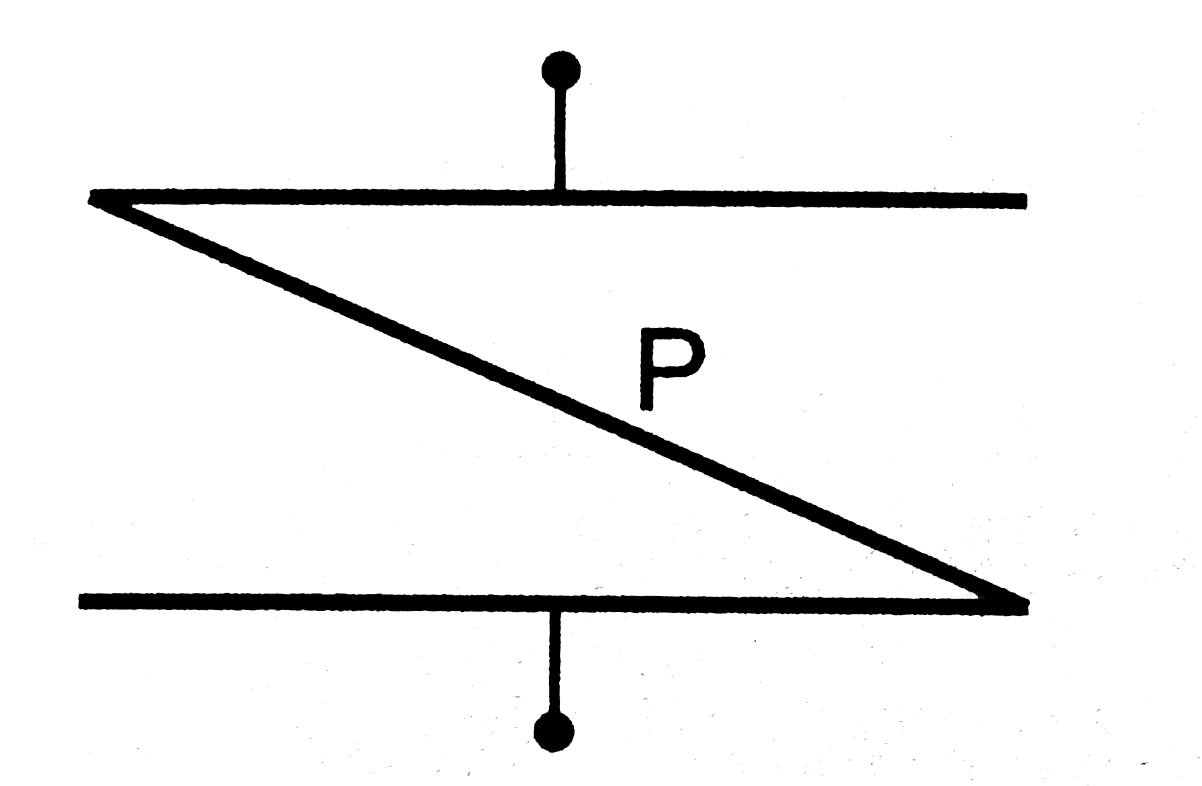 01:46View Solution
01:46View SolutionA capacitor of capacity C hasd charge Q and stored energy is W. if the charge is increased to 2Q, then the stored energy will be
01:38View SolutionA `2 muF` capacitor is charged to `100 V`, and then its plates are connected by a conducting Wire. The heat produced is .
01:21View SolutionIf there are n capacitors in parallel connected to V volt source, then the energy stored is equal to
01:39View SolutionA variable condenser is permanetly connect to a `100V` battery. If the capacity is charged from `2muE` to `10muF`, then change in energy is equal to
01:47View SolutionTwo condensers of capacity `0.3 muF` and `0.6muF` respectively are connected in series. The combination is connected across a potential of `6` volts. The ratio of energies stored by the condensers will be
01:51View SolutionA capacity of capacity `C_(1)` is charged up to `V` volt and then connected to an uncharged capacitor of capacity `C_(2)`. Then final potential difference across each will be
01:39View SolutionA capacitor is charged by using a battery which is then disconnected. A dielectric slab is then slipped between the plates, which results in
02:58View SolutionA parallel plate air capacitor is charged to a potential difference of `V` volts. After disconnecting the charging battery the distance between the plates of the capacitor is increased using an isulating handle. As a result the potential difference between the plates
01:51View SolutionTwo concentric metallic spherical shells are given positive charges . Then
01:53View SolutionDielectric constant of pure water is 81. Its permittivity will be
01:51View SolutionTwo spherical conductors each of capacity `C` are charged to potetnial `V` and `-V`. These are then conneted by means of a fine wire. The loss of energy will be
04:17View SolutionTwo spheres A and B of radius 4 cm and 6 cm are given charges of `80 muC and 40 muC`, respectively. If they are connected by a fine wire, then the amount of charge flowing from one to the other is
05:51View SolutionThe electric potential difference between two parallel plates is `2000 V`. If the plates are separated by 2 mm, then what is the magnitude of electrostatic force on a charge of `4 xx 10^(-6)C` located midway between the plates ?
02:53View SolutionTwo conducting spheres A and B of radii 4 cm and 2 cm carry charges of `18 xx 10^(-8)` statcoulomb and `9 xx 10^(-8)` statcoulomb respectively of positive electricity. When they are put in electrostatic contact, then the charge will
03:35View SolutionThe insulated spheres of radii `R_(1)` and `R_(2)` having charges `Q_(1)` and `Q_(2)` respectively are connected to each other. There is
06:31View SolutionA small sphere is charged to a potential of 50 V and a big hollow sphere is charged to a potential of 100 V. Electricity will flow from the smaller sphere to the bigger one when
03:44View SolutionTwo identical charges are placed at the two corners of an equilateral triangle. The potential energy of the system is U. The work done in bringing an identical charge from infinity to the third vertex is
03:26View SolutionFour electric charges `+q, +q, -q` and `-q` are placed at the corners of a square of side 2L (see figure). The electric potential at point `A`, mid-way between the two charges `+q` and `+q`, is
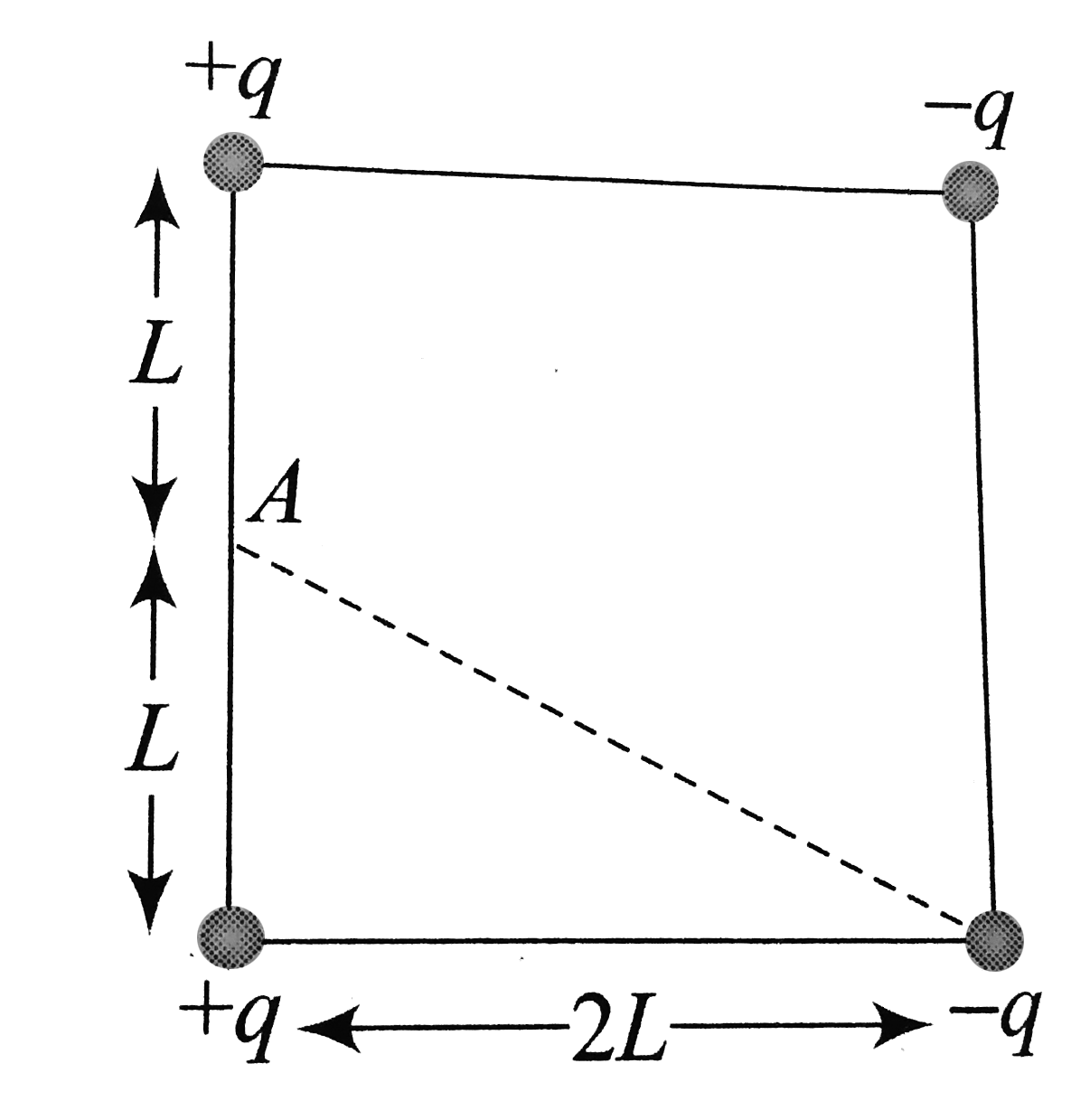 02:21View Solution
02:21View SolutionA hollow metal sphere of radius 10cm is charged such that the potential on its surface is 80 V. The potential at the centre of the sphere is
01:51View SolutionA parallel plate condenser has a unifrom electric field `E (V//m)` in the space between the plates. If the distance between the plates is `d(m)` and area of each plate is `A(m^(2))` the energy (joule) stored in the condenser is
01:35View SolutionCharges `5 muC and 10 muC` are placed 1 m apart. Work done to bring these charges at a distance 0.5 m from each other is `(k = 9 xx 10^(9) SI)`
03:19View SolutionA particle of mass `2 xx 10^(-3)` kg, charge `4 xx 10^(-3)C` enters in an electric field of `5 V//m`, then its kinetic energy after 10 s is
03:19View SolutionThe ionisation potential of mercury is 10.39 V. How far an electron must travel in an electric field of `1.5 xx 10^(6) V//m` to gain sufficient energy to ionise mercury ?
02:17View Solution`0.2 F` capacitor is charged to `600 V` by a battery. On removing the battery it is connected with another parallel plate capacitor of `1 F`. The potential decreases to
03:17View SolutionThe work done in placing a charge of `8xx10^-18` coulomb on a condenser of capacity 100 micro-farad is
02:27View SolutionIn a parallel plate capacitor, the separation between the plates is 3mm with air between them. Now a 1mm thick layer of a material of dielectric constant 2 is introduced between the plates due to which the capacity increases. In order to bring its capacity of the original value, the separation between the plates must be made-
03:30View SolutionThe electric potential at any point `x,y an z` in metres is given by `V = 3x^(2)`. The electric field at a point `(2,0,1)` is
03:02View SolutionAn electron of mass `m` and charge `e` is accelerated from rest through a potential difference `V` in vacuum. The final speed of the electron will be
02:01View SolutionIf an electron moves from rest from a point at which potential is `50` volt to another point at which potential is `70` volt, then its kinetic energy in the final state will be
01:57View SolutionThe work done in bringing a `20` coulomb charge from point `A` to point `B` for disatnce `0.2 m` is `2 J`. The potential difference between the two points will be (in volt)
01:18View SolutionIf `4 xx 10^(20)eV` energy is required to move a charge of `0.25` coulomb between two points. Then what will be the potential difference between them ?
01:41View SolutionKinetic energy of an electron accelerated in a potential difference of `100 V` is
01:14View SolutionA hollow conducting sphere is placed in an electric field produced by a point charge placed at `P` as shown in figure.
Let `V_(A), V_(B), V_(C )` be the potentials at points `A, B and C` respectively. Then
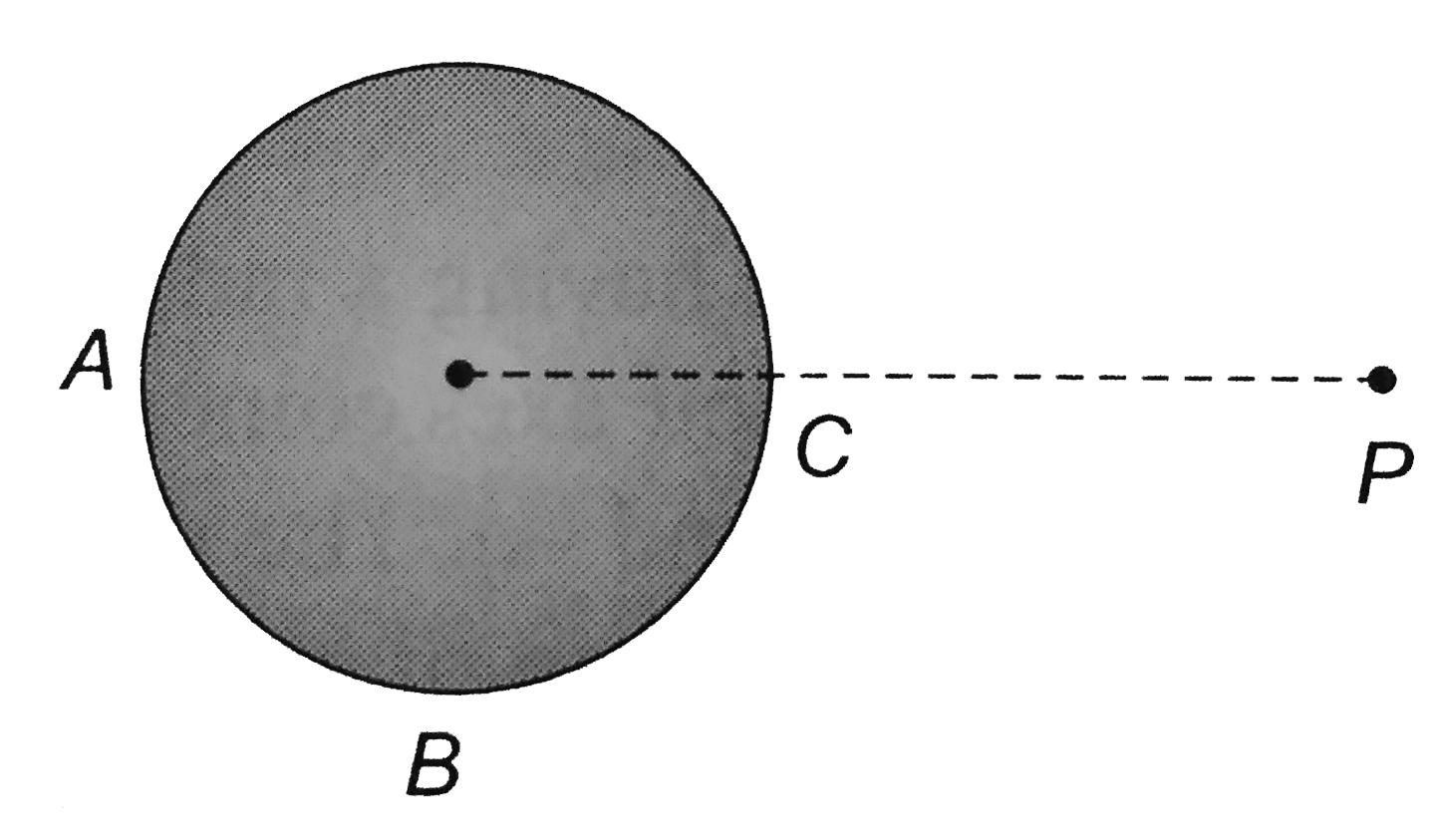 01:25View Solution
01:25View SolutionTwo unlike charges of magnitude `q` are separated by a distance `2d`. The potential at a point midway between them is
01:18View SolutionTwo spheres `A` and `B` of radius 'a' and 'b' respectively are at same electric potential. The ratio of the surface charge densities of `A` and `B` is
02:10View SolutionA capacitorn of `2 muF` charged to 50 V is connected in parallel with another capacitor of `1 muF` charged to 20 V. The common potential and loss of energy will be
05:45View SolutionIn the electric field of a point chargde `q`, a cetrain charge is carried from point `A` to `B, C, D` and `E`. Then the ork done
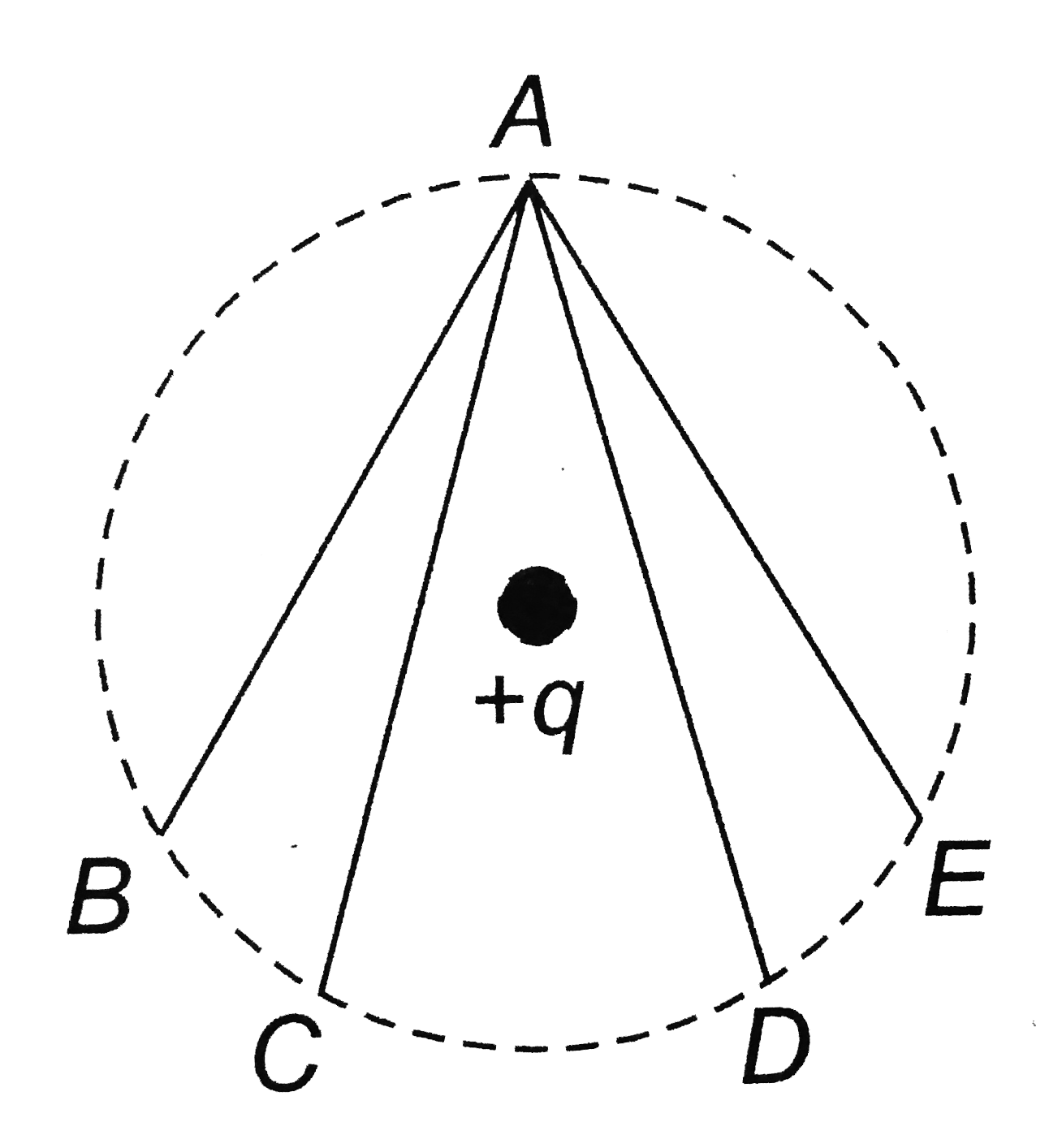 02:09View Solution
02:09View SolutionA unifrom electric field having a magnitude `E_(0)` and direction along the positive X-axis exists. If the protential `V` is zero at `x = 0`, then its value at `X = +x` will be
01:19View SolutionTwo positive point charges of 12 and 5 microcoulombs, are placed 10 cm apart in air. The work needed to bring them 4 cm closer is
04:57View SolutionWhen a charge of `3` coulombs is placed in a uniform electric field, it experiences a force of `3000` netwon. Within this field, potential difference between two points separated by a distance of `1 cm` is
01:28View SolutionA particle `A` has chrage `+q` and a particle `B` has charge `+4q` with each of them having the same mass `m`. When allowed to fall from rest through the same electric potential difference, the ratio of their speed `(v_(A))/(v_(B))` will become
02:09View SolutionThree particles, each having a charge of `10 mu C` are placed at the coners of an equilateral triangle of side `10 cm`. The electrostatic potential energy of the system is (Given `(1)/(4pi epsilon_(0)) = 9 xx 10^(9)N-m^(2)//C^(2))`
02:06View SolutionA mass `m=20 g` has a charge `q= 3.0 mC`. It moves with a velocity of 20 m/s and enters a region of electric field of 80 N/C in the same direction as the velocity of the mass. The velocity of the mass after 3 s in this region is
02:33View SolutionFour idenbtial charges `+50 mu C` each are placed, one at each corner of a square of side `2 m`. How much external energy is required to bring another charge of `+50 mu C` from infinity to the centre of the square
(Given `(1)/(4pi epsilon_(0)) = 9 xx 10^(9)(Nm^(2))/(C^(2)))`02:45View SolutionTwo equal charges `q` are placed at a distance of `2a` and a third charge `-2a` is placed at the midpoint. The potential energy of the system is
02:23View SolutionAn `alpha`-particle is accelerated through a.p.d of `10^(6)` volt the `K.E.` of particle will be
00:59View SolutionThe ratio of moment of an electron and an `alpha`-particle which are accelerated from rest by a potential difference of `100V` is
01:55View SolutionTwo particles of mass `m` and `2m` with charges 2q and q are placed in a uniform electric field E and allowed to move for same time. Find the ratio of their kinetic energie
04:55View SolutionA spherical condenser has innder and outer spheres of radii a and b respectively. The space between the two is filled with air. The difference between the capacities of two condensers formed when outer sphere is earthed and when inner sphere is earthed will be
View SolutionThree charges are placed at the vertices of an equilateral triangle of side 10 cm. Assume `q_(1)=1 muC,q_(2)=-2 muC and q_(3)=4 muC`. Work done in separating the charges to infinity is
05:03View SolutionA particle of mass 2 g and charge `1 muC` is held at rest on a frictionless surface at a distance of 1m from a fixed charge of 1 mC. If the particle is released it will be repelled. The speed of the particle when it is at distance of 10 m from fixed charge is :
07:40View SolutionA point charge is surrounded symmetrically by six identical charges at distance `r` as shown in the figure How much work is done by the froces of electrostatic repulsion when the point charge at the centre is removed to infinity ?
 02:10View Solution
02:10View SolutionFive capacitors of `10 muF` capacity each are connected to a `d.c` potential of `100` volts as shown in the adjoining figure. The equivalent capacitance between the points `A` and `B` will be equal to
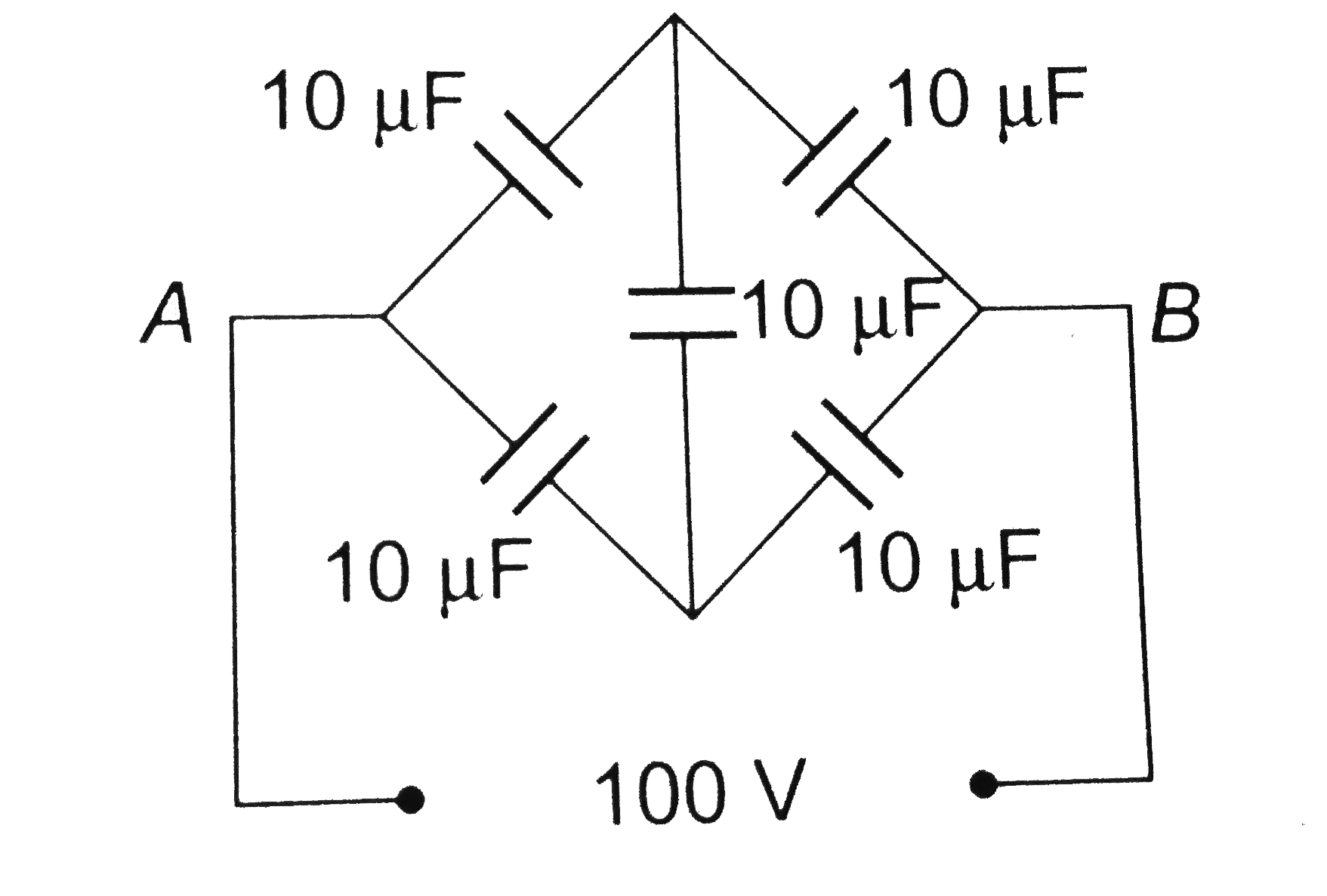 02:19View Solution
02:19View SolutionThree capacitors of capacitances `3 muF, 9muF` and `18 muF` are connected one in series and another time in parallel. The ratio of equivalent capacitance in the two cases `((C_(s))/(C_(p)))` will be
01:53View SolutionIn the circuit diagram shown in the adjoining figure, the resultant capacitance between `P` and `Q` is
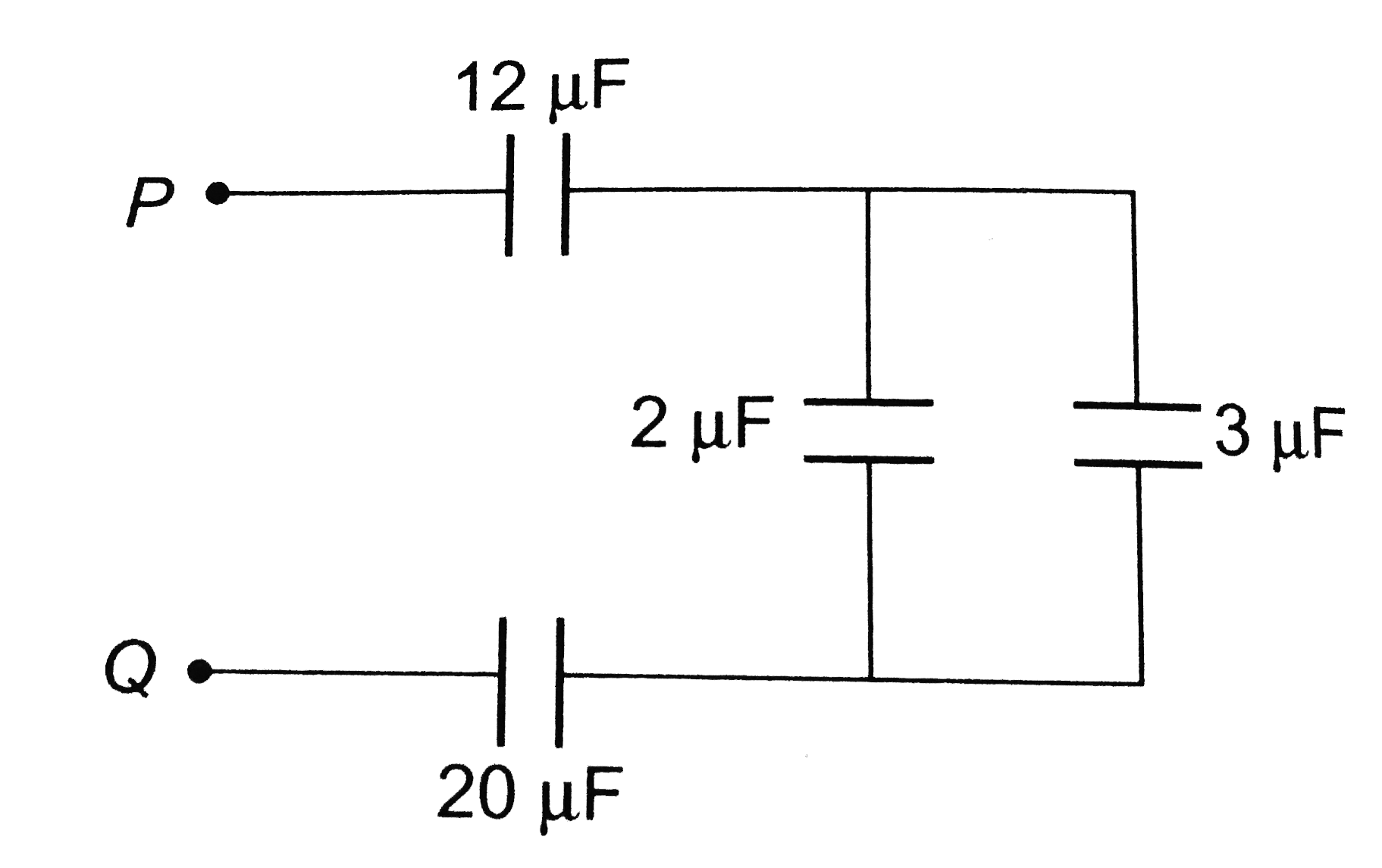 02:09View Solution
02:09View SolutionFour capacitors of each of capacity `3 muF` are connected as shown in the adjoining figure. The ratio of equivalent capacitance between `A` and `B` and between `A` and `C` will be
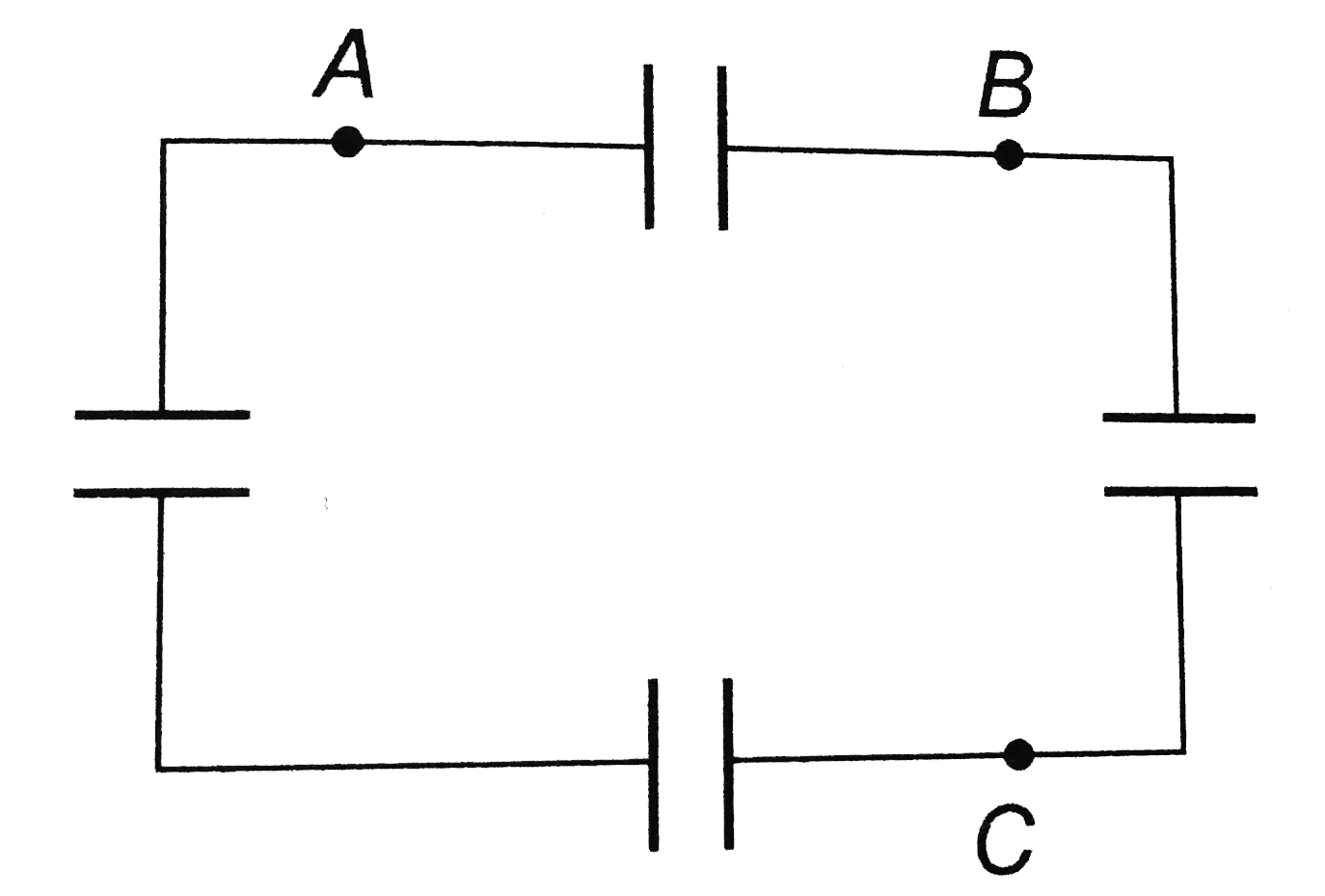 03:03View Solution
03:03View SolutionWhat is the equivalent capacitance between A and B in the given figure (all are in farad) ?
 View Solution
View SolutionFour capacitors are connected as shown . The equivalent capacitance between the points P and Q is
 View Solution
View SolutionThe total capacity of the system of capacitors shown in the adjoining figure between the points `A` and `B` is
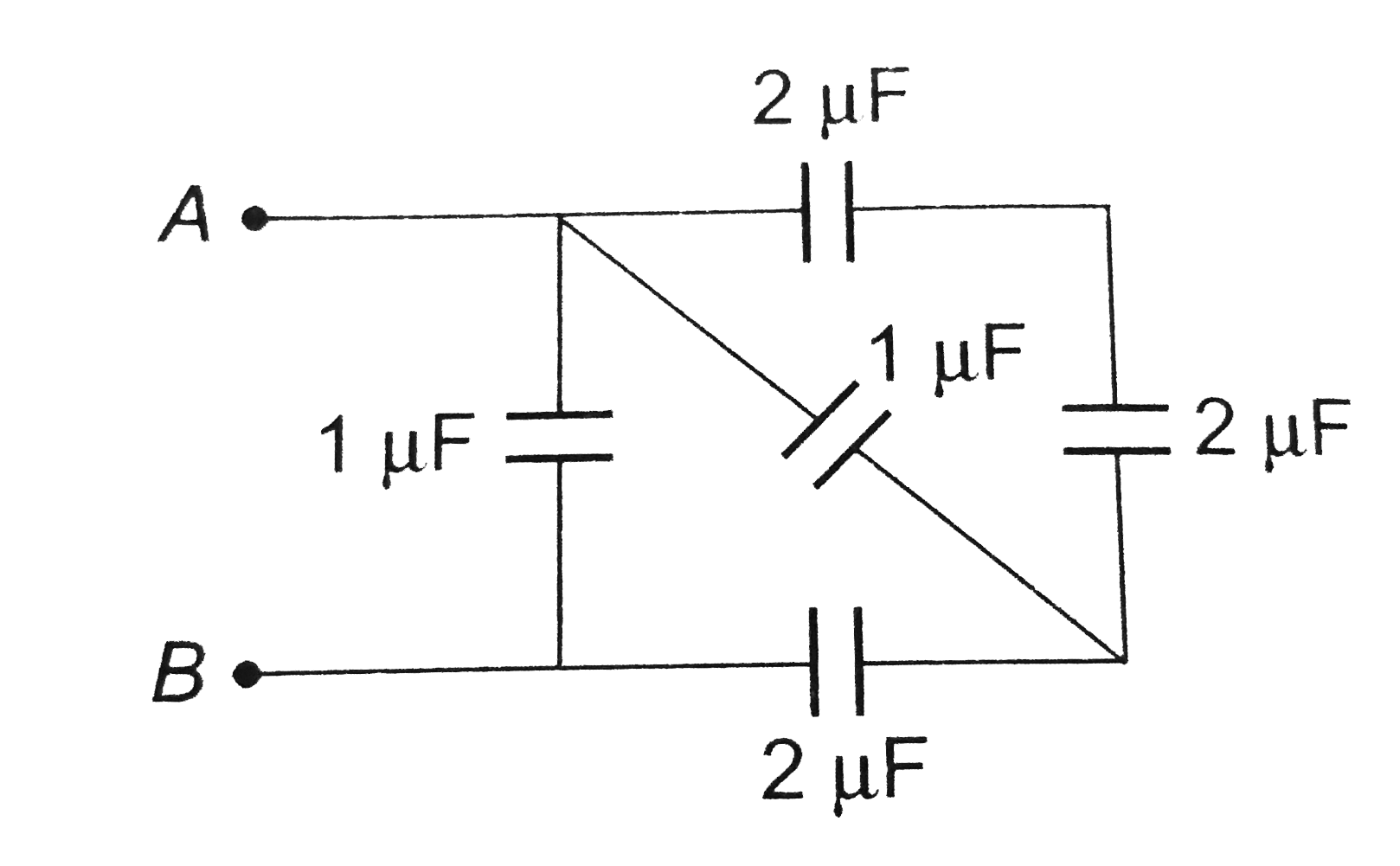 02:19View Solution
02:19View SolutionFour capacitors are connected in a circuit as shown in the figure. The effective capacitance in `muF` between points `A` and `B` will be
 02:20View Solution
02:20View SolutionIn the given network capacitance, `C_(1) = 10muF, C_(2) = 5 muF` and `C_(3) = 4muF`. What is the resultant capacitance between `A` and `B`?
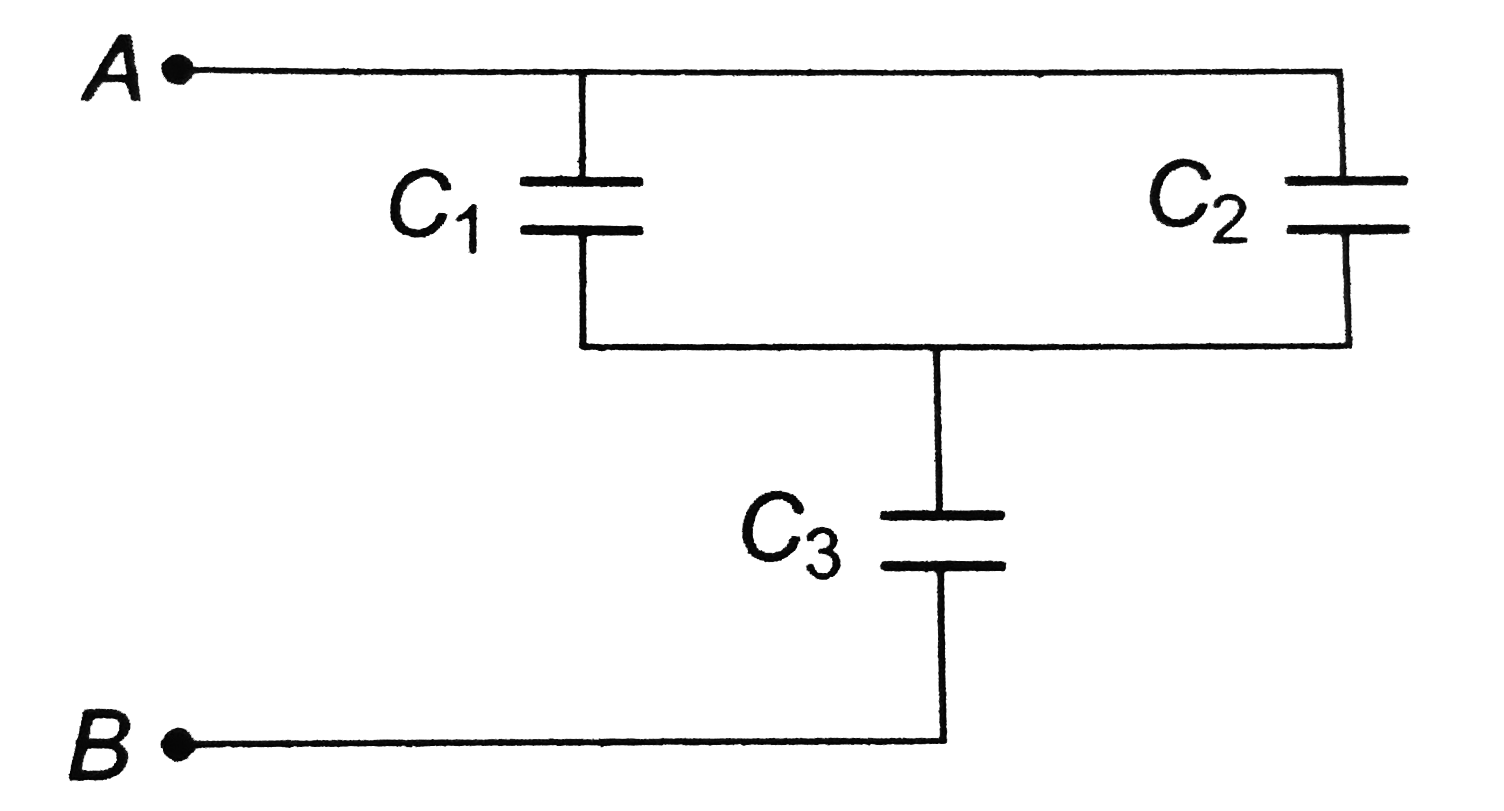 01:55View Solution
01:55View SolutionThe equivalent capacitance between points A and B is
 View Solution
View SolutionThe capacitance between the points `A` and `B` in the given circuit will be
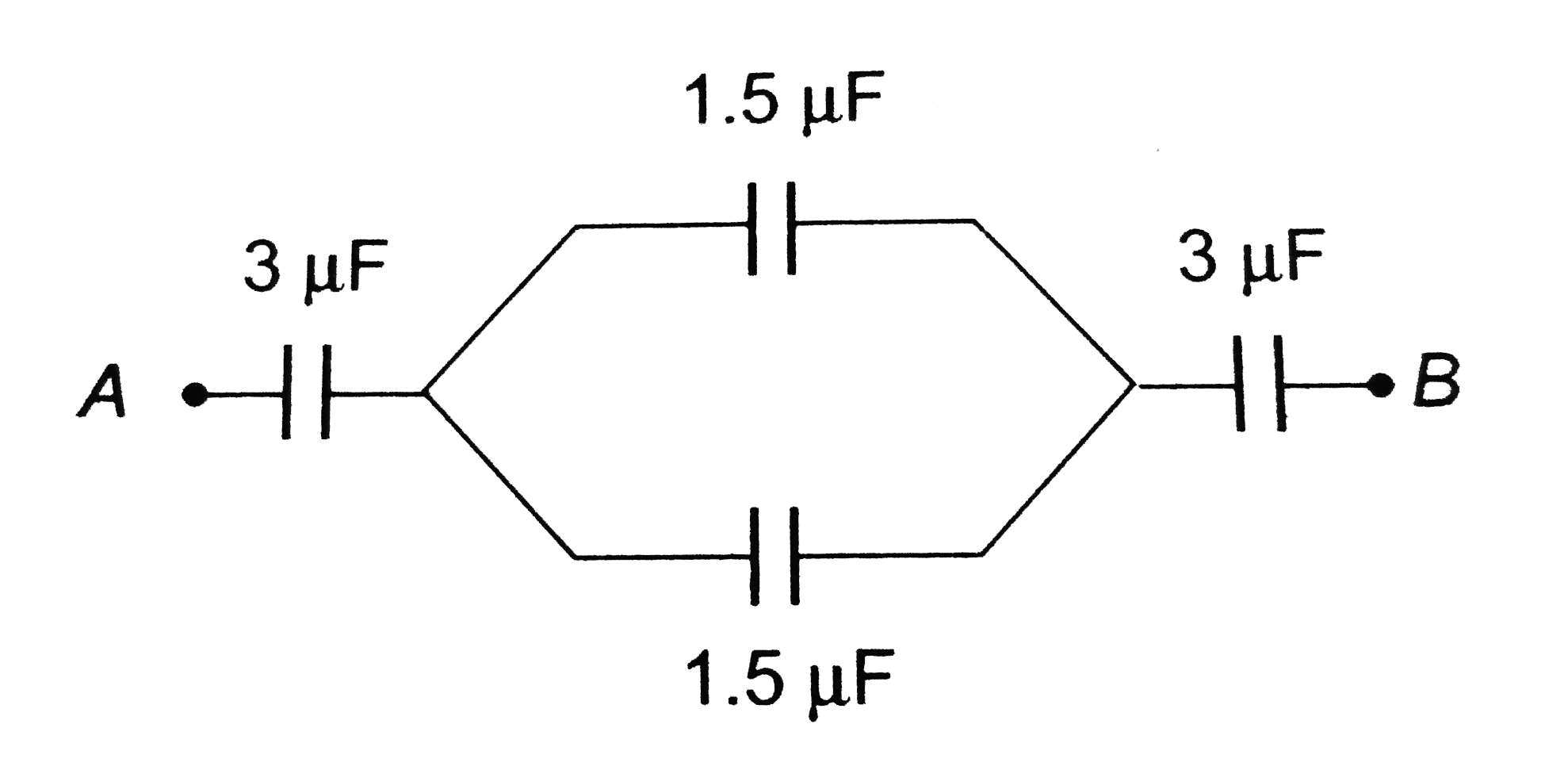 01:32View Solution
01:32View SolutionFour equal capacitors, each of capacity `C`, are arranged as shown. The effective capacitance between `A` and `B` is
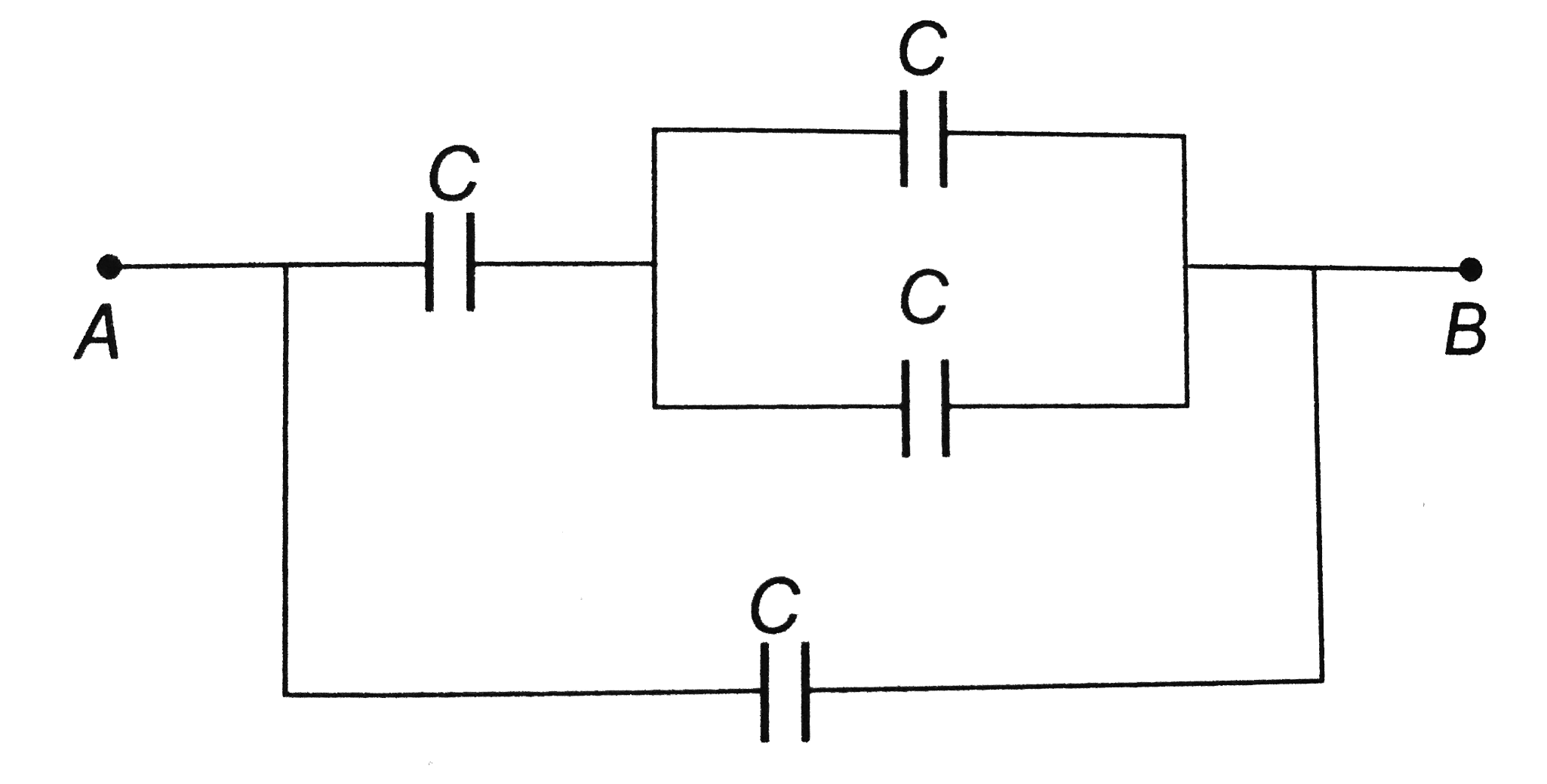 02:02View Solution
02:02View SolutionThere are 7 identical capacitors. The equivalent capacitance when they are connected in series is C. The equivalent capacitance when they are connected in parallel is
02:51View SolutionThe capacitance of a parallel plate capacitor is `16 mu F`. When a glass slab is placed between the plates, the potential difference reduces to 1/8th of the original value. What is dielectric constant of glass ?
03:03View SolutionA parallel plate condenser with air between the plates possesses the capacity of `10^(-12) F` .Now, the plates are removed apart, so that the separation is twice the original value. The space between the plates is filled with a material of dielectric constant 4.0. Then new value of the capacity is (in farad)
03:21View Solution
(A) Chapter exercises questions and complete solutions for chapter ELECTROSTATIC POTENTIAL AND CAPACITORS of DC PANDEY PHYSICS (HINGLISH) of Class 12
